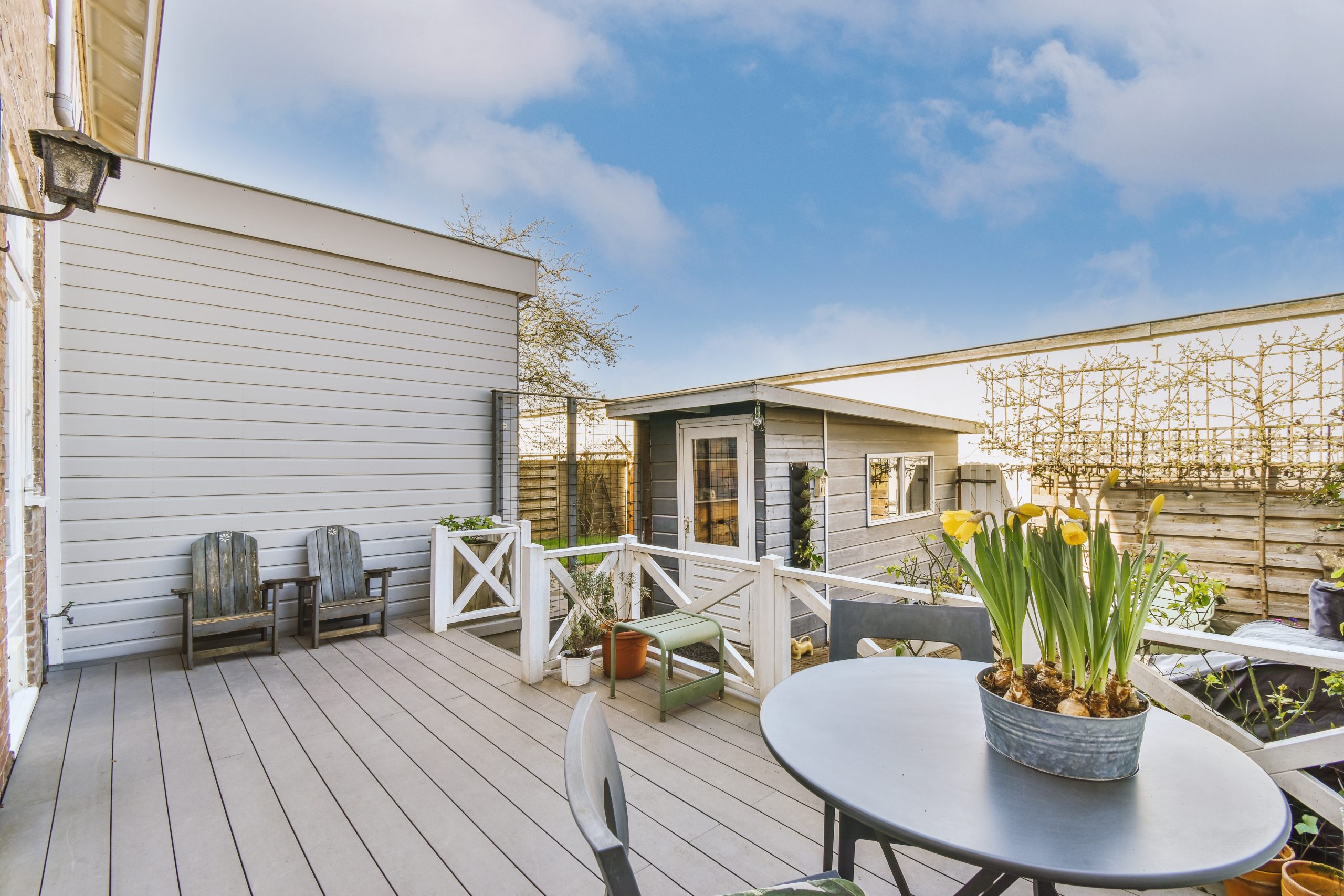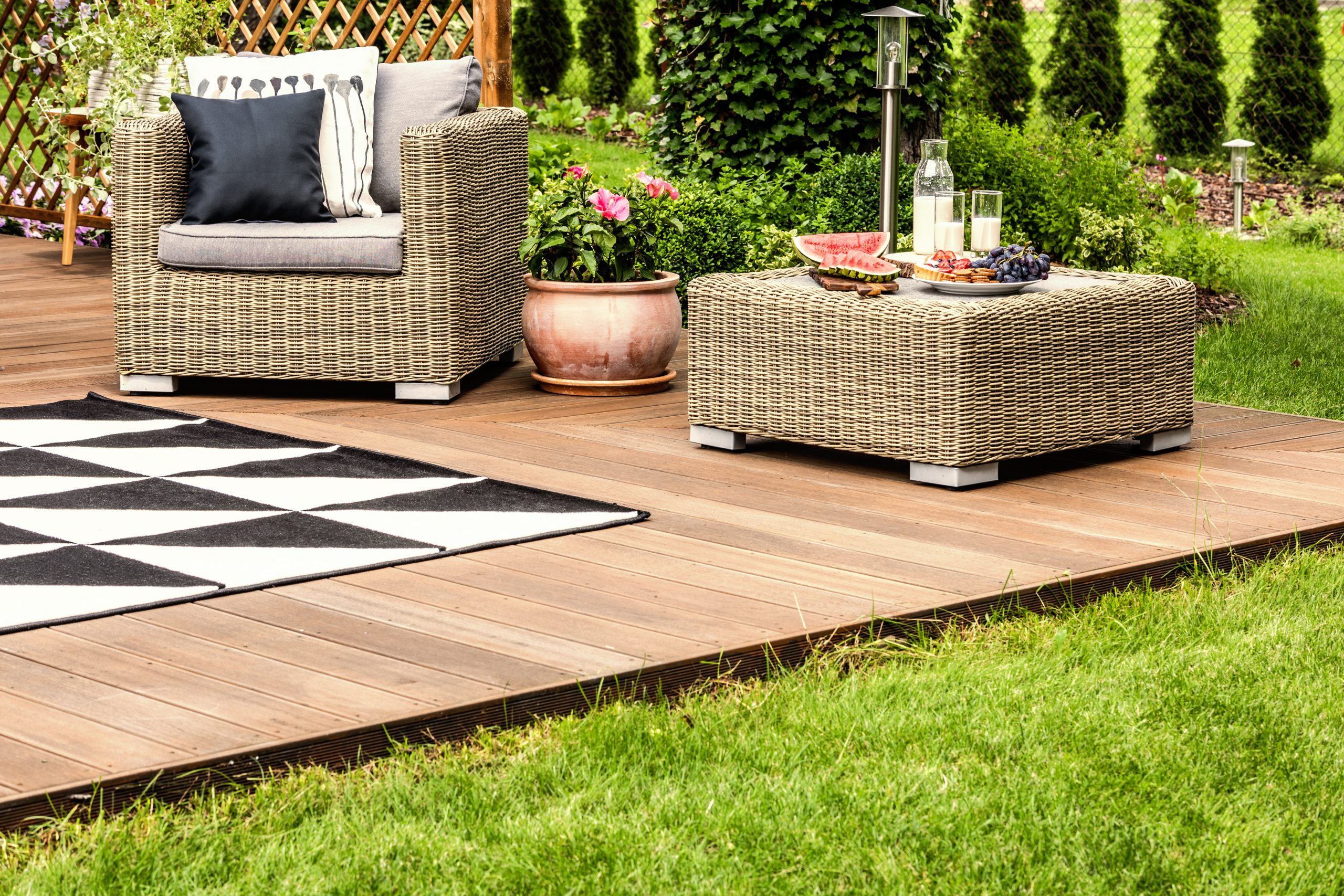
Discovering the perfect outdoor deck material can be tough. From the countless customers we’ve interacted with, the consensus is that homeowners find it tricky to choose the right patio materials among several decking types, so they come to us for advice and guidance.
It gets overwhelming with so many options, each with its own perks and downsides. But fear not! Simplifying the quest for the best outdoor deck material options is possible.
When you grasp the details of the types of decking material and match them with your patio needs, you make better choices.
This comparison of decking materials is your definitive guide, making it easier to find the ideal match for your patio.
What are the different types of decking material?
So, what are decks made out of and what are the different types of deck boards?
Well, it comes down to this simple list, each of which is suitable for different deck designs and situations, so we’ll go into more detail on these shortly.
- Hardwood
- Softwood
- Pressure-treated wood
- Mineral-based composite
- Capped composite
- Uncapped composite
- PVC
- Aluminum
- Engineered
- Concrete
Outdoor deck materials comparison chart
Use the below table for an overall glance as to the deck material comparisons, and we’ll then go into more detail on the different material types.
| Material | Best for | Not so good for | Avg. cost per square foot |
| Hardwood | Luxurious outdoor aesthetics | Affordability | $8 to $ 12 |
| Softwood | Budget-friendly options compared to hardwood | Areas with high moisture or heavy foot traffic–prone to dents, scratches, and decay | $3 to $7 |
| Pressure-treated wood | Generally budget-friendly | Homeowners who avoid frequent maintenance | $2 to $5 |
| Mineral-based composite | Durable, low maintenance, and environment-friendly | Places with extreme heat and prolonged exposure to sunlight | $4 to $8 |
| Capped composite | Enhanced durability and aesthetics | Affordability | $5 to $12 |
| Uncapped composite | Affordable and low maintenance | Damp environments–more susceptible to mild and mildew | $3 to $7 |
| PVC | Exceptional durability and low maintenance | Affordability | $10 to $15 |
| Aluminum | Durable, low maintenance, and weather-resistant | Affordability | $25 to $50 |
| Engineered | Durable, low maintenance, and versatile | Low initial cost and long-lasting | $4 to $9 |
| Concrete | Durable, versatile, and long-lasting | Places with extreme heat–susceptible to cracking over time | $6 to $15 |
If you’re in Wisconsin and would like to discuss your decking project, don’t hesitate to give us a call for a free quotation
Before we go into more detail on the above common decking materials, here’s a bit more information on choosing the best decking…
Why choosing the right deck building materials is important
Selecting the appropriate deck building materials holds paramount importance in crafting an enduring outdoor space.
From durability and aesthetics to weather resistance, making informed choices ensures a deck that withstands the elements and time while complementing your lifestyle and enhancing your home’s value.
How local climate impacts your choice of deck materials
From scorching summers to freezing winters, different regions experience varying weather conditions.
Selecting a new decking material that can withstand your area’s specific climate ensures your deck stands the test of time.
Modern decking materials are designed with weather-resistant properties, safeguarding against moisture, extreme temperatures, and UV rays.
Ground-level vs. rooftop decks
Ground-level decks encounter direct contact with soil and moisture, requiring durable decking material capable of resisting rot and decay.
Conversely, rooftop decks face unique challenges like increased exposure to wind and sunlight, demanding resilient materials that can endure these conditions without compromising structural integrity.
Modern decking materials
Gone are the days of traditional wood-only options.
Modern decking materials offer many advantages, including:
- Enhanced durability
- Low maintenance
- Extended lifespan.
Opting for these advanced materials ensures a longer-lasting deck that retains its beauty despite weather changes, heavy foot traffic, or other external factors.
The Long-Term Benefits of Robust Deck Surfaces
A durable decking material isn’t merely about initial strength; it’s an investment in longevity.
Choosing a durable deck surface material means fewer repairs, replacements, and maintenance costs down the road.
With materials resistant to cracks, warping, rot, and insect damage, you can enjoy your deck for years without worrying about frequent upkeep.
What are the best deck material options? Here’s our top 10 list:
Looking for the best deck material options?
Learn more about decking materials and find the perfect solution for you, from time-tested wood choices to cutting-edge and cheapest decking material.
1. Hardwood (best decking material 2024)

Hardwood is renowned for being the best wood for decks and for its timeless elegance and natural durability.
Derived from various types of trees like teak, ipe, mahogany, and cumaru, this decking material exudes a rich, sophisticated appeal.
Its inherent strength and robustness make it a popular choice among homeowners seeking a luxurious outdoor aesthetic.
Pros:
- Aesthetic Appeal: Hardwood exudes natural beauty with its rich colors and unique grain patterns, enhancing the overall look of your outdoor space.
- Durability: Known for its toughness, hardwood decking boasts exceptional resistance to wear, rot, insects, and decay.
- Longevity: With proper maintenance, hardwood decks can last for decades, adding long-term value to your property.
Cons:
- Cost: Hardwood is often pricier than other decking materials due to its premium quality and limited availability.
- Maintenance: Requires periodic sealing or oiling to maintain its appearance and protect against weathering.
- Environmental Concerns: Some hardwood species might not be sustainably sourced, prompting environmental considerations.
Cost
The cost of hardwood decking can vary significantly based on the type of wood chosen and its availability.
On average, hardwood decking materials can range from $8 to $12 per square foot for materials alone.
2. Softwood (top patio decking material)
Softwood decking comprises wood from coniferous trees like cedar, pine, and redwood.
It’s a popular choice for decking due to its versatility and affordability, also offering a warm, natural appeal and is readily available, making it a common selection for many outdoor projects.
Pros:
- Affordability: Generally more budget-friendly compared to hardwood and other decking materials, making it accessible to a wider range of homeowners.
- Natural Look: Offer a rustic and inviting appearance, blending well with various outdoor aesthetics.
- Ease of Installation: Its lightweight nature and workability make softwood decking easier to handle and install.
Cons:
- Durability: While softwood is naturally resilient, it is more prone to dents, scratches, and decay compared to hardwood.
- Maintenance: Requires regular sealing or staining to protect against weathering, insects, and rot.
- Lifespan: May have a shorter lifespan compared to hardwood, requiring more frequent maintenance and eventual replacement.
Cost
Softwood decking tends to be more affordable than hardwood, with costs averaging between $3 to $7 per square foot for materials.
3. Pressure-treated wood (best decking material for full sun exposure)
Many customers go for pressure-treated wood decking due to its cost-effectiveness and durability, especially for full sun exposure.
This type of wood undergoes a preservation process where chemicals are forced into the wood fibers, enhancing its resistance to rot, insects, and decay.
Often made from Southern Yellow Pine or other softwoods, it’s a widely used decking material.
Pros:
- Affordability: Among the most budget-friendly options for decking materials, making it accessible for various projects.
- Resistance to Decay: The treatment process significantly improves the wood’s resistance to decay, extending its lifespan.
- Availability: Widely available in most lumberyards and home improvement stores, making it easy to find.
Cons:
- Maintenance: More resistant to decay, but it still requires regular maintenance, such as staining or sealing, to prolong its lifespan.
- Potential for Warping: Exposure to weather elements over time might cause pressure-treated wood to warp, crack, or splinter.
- Chemicals: The chemicals used in the treatment process can concern some individuals, although modern treatments are generally considered safe for residential use.
Cost
Pressure-treated wood is known for its affordability, with prices averaging between $2 to $5 per square foot for materials.
4. Mineral-based composite (best deck boards for patio decks)

Mineral-based composite decking represents a cutting-edge innovation in the decking industry and are one of the best boards for decking.
Composite decking is the best option if you’re looking for a green alternative since composite decking is made of a blend of recycled plastics, natural minerals, and wood fibers, engineered to offer superior durability and sustainability.
Mineral-based composite boards often mimic the look of natural wood while providing enhanced performance.
Pros:
- Durability: Exceptional resistance to rot, mold, mildew, and insect damage, ensuring longevity.
- Low-Maintenance Deck: Unlike traditional wood decking, these composites require minimal upkeep, usually needing only occasional cleaning.
- Environmentally Friendly: Made from recycled materials, they contribute to sustainable building practices.
Cons:
- Initial Cost: Tends to have a higher initial cost compared to some traditional materials like pressure-treated wood.
- Color Fading: Prolonged exposure to sunlight may cause slight color fading over time, although many are designed to mitigate this issue.
- Surface Temperature: In extreme heat, some may retain more heat than natural wood.
Cost
Mineral-based composite decking typically ranges from $4 to $8 per square foot for materials.
5. Capped composite (a good patio deck material!)
Capped composite decking represents high-performance patio deck material options.
This type of decking is constructed from a blend of wood fibers, recycled plastics, and a protective outer layer (cap) that shields the board from moisture, stains, and fading.
Capped composites are celebrated for their durability and low-maintenance qualities.
Pros:
- Enhanced Durability: The protective cap offers superior resistance to scratches, stains, and fading, ensuring a longer lifespan.
- Low Maintenance: Require minimal upkeep, usually limited to occasional cleaning with soap and water.
- Aesthetics: Mimicking the natural look of wood, they’re available in a wide range of colors and grain patterns.
Cons:
- Higher Cost: Tends to have a higher upfront cost compared to other materials like pressure-treated wood or standard composites.
- Heat Retention: In extreme temperatures, they may retain more heat than natural wood.
- Limited Recycling: The addition of a protective cap can hinder the recyclability of these materials.
Cost
Capped composite decking typically ranges from $5 to $12 per square foot for materials, depending on the brand, quality, and specific features such as enhanced durability or unique color options.
If you’re a Wisconsinite and have already decided on what material you’d like, contact our team today so we can help build you the best decking you deserve.
6. Uncapped composite

In comparing composite materials and capped vs. uncapped, uncapped composite decking is also made from recycled plastics and wood fibers, akin to capped composite, but it lacks the protective outer layer.
When considering PVC vs composite decking, uncapped versions present a cost-effective alternative for decking projects, sharing traits with capped composites but without the added expense.
Pros:
- Affordability: Typically comes at a lower price compared to capped composite or other premium decking materials.
- Low Maintenance: Like its capped counterpart, it requires minimal maintenance, usually requiring simple cleaning.
- Natural Appearance: Provides a wood-like appearance without the high maintenance associated with traditional wood decks.
Cons:
- Susceptibility to Stains: Might be more prone to staining and fading compared to capped varieties.
- Less Scratch Resistance: Lacks the protective cap, making it slightly more susceptible to scratches and wear over time.
- Potential for Mold Growth: Without the protective cap, uncapped composite might be more susceptible to mold and mildew in damp environments.
Cost
Uncapped composite decking usually ranges from $3 to $7 per square foot for materials.
7. PVC (ideal decking for sunny patios)
PVC (polyvinyl chloride) decking is a synthetic decking material made entirely from plastic.
Renowned for its exceptional durability and minimal maintenance requirements, PVC decking offers a resilient solution for creating beautiful outdoor spaces.
Pros:
- Exceptional Durability: PVC decking is highly resistant to moisture, mold, mildew, and insect damage, ensuring longevity even in harsh weather conditions.
- Low Maintenance: Requires minimal upkeep, usually just periodic cleaning with soap and water, and doesn’t need staining, sealing, or painting.
- Color Retention: Tends to maintain its color and appearance over time, resisting fading caused by UV exposure.
Cons:
- Higher Cost: Typically more expensive than other decking materials due to its advanced features and durability.
- Heat Retention: In extreme temperatures, it may retain more heat compared to some other materials.
- Limited Aesthetics: Some PVC decks might lack the natural appearance of wood, although modern designs strive to mimic wood grain textures.
Cost
PVC decking usually ranges from $10 to $15 per square foot for materials. The cost may vary based on the brand, quality, and additional features offered, contributing to its higher initial investment.
8. Aluminum (great for sunlit spaces)
Aluminum decking is an innovative choice that combines strength, durability, and modern aesthetics.
Constructed from powder-coated or anodized aluminum, it offers exceptional weather resistance and a sleek, contemporary look.
Pros:
- Durability: Highly resistant to rust, rot, corrosion, and insect damage, ensuring a long-lasting deck.
- Low Maintenance: Requires minimal upkeep, usually limited to occasional cleaning with soap and water to maintain its appearance.
- Weather Resistance: Withstands extreme weather conditions, including UV exposure, without warping, cracking, or fading.
Cons:
- Higher Cost: Higher initial cost compared to traditional wood or composite options.
- Heat Retention: Aluminum may retain more heat than some other materials, making it warm to the touch in intense sunlight.
- Limited Aesthetics: While available in various finishes and designs, it might not offer the same natural appearance as wood.
Cost
Aluminum decking generally ranges from $25 to $50 per square foot for materials. The cost varies based on the brand, quality, and specific features such as finishes or coatings.
9. Engineered

Engineered decking represents a composite material that blends various elements like wood fibers, recycled plastics, and binding agents.
This composite construction results in a durable, versatile, and often eco-friendly decking solution, offering a balance between performance and aesthetics.
Pros:
- Durability: High durability, resisting rot, decay, and insect damage, ensuring a longer lifespan.
- Low Maintenance: Requires minimal maintenance, typically needing occasional cleaning to preserve its appearance.
- Versatility: Comes in various colors, textures, and finishes, allowing for diverse customization options.
Cons:
- Initial Cost: Can have a higher upfront cost compared to some traditional materials like pressure-treated wood.
- Susceptibility to Fading: Some materials may experience slight fading or color changes over time due to UV exposure.
- Heat Retention: Similar to other composite materials, engineered decking may retain more heat than natural wood.
Cost
Engineered decking typically ranges from $4 to $9 per square foot for materials.
10. Concrete Decking
image here if possible
While not a conventional choice for elevated decks due to its weight, concrete is durable and finds use in certain settings such as ground-level patios, poolside areas, or as a base material for specific decking applications.
Pros:
- Durability: Exceptionally durable and can withstand various weather conditions without warping, rotting, or insect damage.
- Versatility: It can be shaped and textured to create various designs, patterns, or finishes, offering aesthetic flexibility.
- Longevity: Properly installed and maintained, concrete decking can have a long lifespan, requiring minimal upkeep.
Cons:
- Weight: Concrete is heavy, making it less suitable for elevated decks and may require additional structural support.
- Cracking: Improperly poured or poorly maintained concrete may be susceptible to cracking over time.
- Surface Temperature: Concrete can absorb and retain heat, potentially becoming uncomfortably warm in direct sunlight.
Cost
The cost of concrete decking varies significantly based on factors such as the area’s size, complexity of design, decorative finishes, and local labor costs.
On average, the price may range from $6 to $15 or more per square foot for materials and labor.
Need help choosing exterior deck flooring materials?
So, what is the best material to use for decks? As you might have guessed, there’s no specific answer to that. You need to choose the best decking for your unique situation, which depends on how much sun it gets, how exposed you are to the elements, budget, and so much more.
For tailored advice or to connect with professional deck builders in Madison, WI, reach out to us today.
Don’t hesitate—get in touch with our knowledgeable team for the finest exterior decking materials and expert guidance tailored to Wisconsin homeowners!
FAQs
Is there a type of exterior decking that lasts forever?
There’s no single decking type that lasts forever. Exterior decking materials inevitably face environmental wear, making perpetual durability improbable Evaluating longevity and maintenance remains crucial, but finding a material lasting forever remains an unattainable feat due to exposure and natural degradation over time.
What deck material lasts the longest?
Composite decking is a long-lasting deck material due to its remarkable durability and resilience. It surpasses wood in longevity, enduring harsh weather conditions with minimal maintenance. However, the optimal choice depends on various factors, including climate, maintenance requirements, and desired aesthetics, all influencing the material’s long-term durability.
What is the most lightweight decking material?
Aluminum stands as a highly popular, lightweight decking material, acknowledged for its robustness and endurance. Compared to wood or composite alternatives, it offers strength with less weight, rendering it an ideal selection for diverse outdoor decking ventures due to its durability and reduced heaviness.





